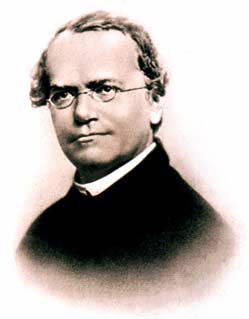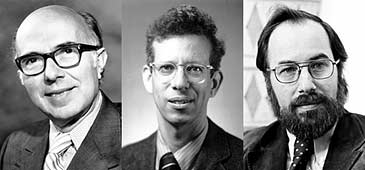![]()
![]()
Individual living cells do not live forever. For life to continue or to evolve, there must be a way for the essentials of life to be duplicated. Unless life had an easy way of starting over from available basic materials, reproduction was an essential function of life. Life on earth has adapted BOTH of these features: Essential information is duplicated AND each organism starts as a single functioning cell which produces differentiated cells to be organized into different tissues and organs providing very diverse specialized functions. Occasional variations provide a mechanism for adapting to variations in surrounding environment. This includes variations in the organism (discussed below) and motion to either move to different environment or to modify the environment (discussed in Controlled Motion).
Growth of individual cells and organisms has been observable since the first life on earth. Mankind has always been fascinated by the origins new individuals and the wide diversity of life on Earth. The ancient Greeks discussed the variations in life and speculated about the connections and differences. Archeological and anthropological data indicate that in prehistoric times, reproduction was attributed to a fertility goddess. In early historical Middle East it was believed that a godly being brought about pregnancy by using male and female contributions. The Greek philosophers following the 6th century B.C. proposed that reproduction was governed by natural laws. Several hypotheses were developed to explain how reproduction might occur. An idea proposed by Aristotle lasted about 2000 years posed that male sperm causes an embryo to develop from menstrual blood in the uterus. Galen alternatively proposed male and female contribute equally in conception and accordingly both had to experience pleasure. Anatomically, the two sexes were presented by Galen as complementary, differing largely in their location inside or outside the respective bodies. Ovaries and testicles were thought to produce seed. However it is difficult to determine the validity of such ideas without microscopic and molecular evidence. Only within the last few years ago has technology begun to provide significant experimental evidence to distinguish the diverse life forms and begin to understand reproduction and variation occurs.
 Taxonomy identifies and names different kinds of organisms. Aristotle suggested an early taxonomy. British naturalist John Wray (b1627, d1705) began to classify plants according to observed similarities and differences. During the 1700s, Swedish botanist Carolus Linnaeus (b1707, d1778 who used this Latinized professional name) establish conventions for the naming of living organisms based on observable structures that became universally accepted in the scientific world. The Linnaean classification system uses a hierarchy, starting with three kingdoms of plants, animals, and minerals. Kingdoms were divided into Classes which were sub-divided into Orders, and those into Genera (singular: genus), which were divided into Species (singular: species). In 1969 the American ecologist Robert Whittaker (b1920, d1980) proposed distinguishing five kingdoms based on ecological function: Plantae, Animalia, Fungi, Protista, and Monera. Carl Woese (b1928, ) in 1990 suggested adding a third domain based on rRNA, Archaea, to Bacteria, and Eukarya. It is now clear that the observable taxonomy distinctions are due to molecular differences in the sub-microscopic nucleic acids which determine the genes. The term genes was coined in 1909 by Danish botanist Wilhelm Johannsen (b1857, d1927) to account for inherited traits investigated in peas by the Austrian monastery priest and teacher, Gregor Johann Mendel (b1822, d1884, at right). Mendel proposed that life is somehow governed by inherited traits, each of which directs a particular function and is faithfully propagated from generation to generation according to set rules. But publication of his findings on plant hybridization in the journal Naturfosch in 1865 remained obscure until uncovered and presented to the Royal Horticultural Society in 1900.
Taxonomy identifies and names different kinds of organisms. Aristotle suggested an early taxonomy. British naturalist John Wray (b1627, d1705) began to classify plants according to observed similarities and differences. During the 1700s, Swedish botanist Carolus Linnaeus (b1707, d1778 who used this Latinized professional name) establish conventions for the naming of living organisms based on observable structures that became universally accepted in the scientific world. The Linnaean classification system uses a hierarchy, starting with three kingdoms of plants, animals, and minerals. Kingdoms were divided into Classes which were sub-divided into Orders, and those into Genera (singular: genus), which were divided into Species (singular: species). In 1969 the American ecologist Robert Whittaker (b1920, d1980) proposed distinguishing five kingdoms based on ecological function: Plantae, Animalia, Fungi, Protista, and Monera. Carl Woese (b1928, ) in 1990 suggested adding a third domain based on rRNA, Archaea, to Bacteria, and Eukarya. It is now clear that the observable taxonomy distinctions are due to molecular differences in the sub-microscopic nucleic acids which determine the genes. The term genes was coined in 1909 by Danish botanist Wilhelm Johannsen (b1857, d1927) to account for inherited traits investigated in peas by the Austrian monastery priest and teacher, Gregor Johann Mendel (b1822, d1884, at right). Mendel proposed that life is somehow governed by inherited traits, each of which directs a particular function and is faithfully propagated from generation to generation according to set rules. But publication of his findings on plant hybridization in the journal Naturfosch in 1865 remained obscure until uncovered and presented to the Royal Horticultural Society in 1900.
The chemistry of the nucleic acids wasn't understood until 1953 when James Watson (b1928, ) and Francis Crick (b1916, d2004) determined how information was embedded in the DNA molecule. In 1957 Francis Crick and George Gamov explained how DNA functions to make protein. They suggested that the DNA sequence specifies the amino acid sequence in synthesizing a protein. They also suggested that genetic information flows only in one direction, from DNA to messenger RNA to protein. The genetic code was cracked
in 1966 by Marshall Nirenberg, Heinrich Mathaei, and Severo Ochoa demonstrated each sequence of three nucleotide bases which specifies which of 20 amino acids is sequenced in protein. (See details in Manufacturing Life)
While studying in the early 1960s an obscure phenomenon called host-controlled modification which occurs during infection of the bacterium Haemophilus influenzae, Werner Arber (b1929, below on left) discovered restriction enzymes. By 1970 Arber showed that these enzymes apparently served to protect a host cell from foreign genes by degrading any foreign DNA. Arber postulated that bacteria contain restriction enzymes with the capacity to recognize and bind to unique recurring DNA nucleotide sequences, severing the DNA-helix only at such locations (and thus leaving its own DNA without such sequences intact).

Hamilton Smith (b 1931, in middle) verified Arber's hypothesis. He purified one restriction enzyme and showed that it could cleave foreign DNA. He determined the nucleotide sequence of the DNA where it was severed by the enzyme and discovered rules which also applied to the over 100 other restriction enzymes which have subsequently been discovered. All cleave DNA, but at different, well defined nucleotide sequences.
Daniel Nathans (b1928, d1999 on right) pioneered the application of using these restriction enzymes to map the nucleotide sequences of the original DNA. He constructed the first genetic map using restriction enzymes by cleaving the DNA from a monkey virus. The methodology devised by him has been used by others to construct increasingly more complicated DNA sequence maps. The process made possible the segmentation of the DNA in a complete set of human chromosomes, the selective cleaving and identification of each successive nuclide, and completion of the computer sequence mapping of the full human nucleic acid sequence in 2001. Their discoveries won Arber, Smith and Nathans the The 1978 Nobel Prize in Physiology or Medicine.
65 years ago Peyton Rous established that cancer can be caused by viruses. But Crick and Gamow had suggested that the flow of information in the cell normally only occurs from cell's DNA to messenger RNA and then from mRNA to proteins and not the reverse. So how could a tumor virus contain either DNA or RNA interfere with this process? Renato Dulbecco (b. 1914 in Catanzaro, Italy; below left) suggested that a tumor virus containing DNA causes its DNA to be incorporated in the infected cell nucleus where it is treated just like the DNA of the cell. Incorporation of hereditary traits carried by the virus could result in unlimited cell growth characteristic of the cancer.
 In the early 1960's Howard Temin proposed that a RNA tumor virus might give rise to a DNA copy which could similarly then be incorporated into the genetic material of the cell. This requires a reversal of the normal flow of information from DNA to RNA, a rather unorthodox and unacceptable idea at that time. But in 1970 Howard Temin (b1934, d1994; in center) and David Baltimore (b1938; at right) independently discovered that RNA tumor viruses contain a special reverse transcriptase enzyme which can make a DNA copy from RNA. David Baltimore and others after 1970 established that infection of cells with RNA tumor viruses indeed leads to the formation of a DNA copy which is incorporated into the DNA of the cell. This mechanism provides a powerful tool for potentially modifying DNA such as in situations were defective genes are the cause of disease or other hardships. Furthermore, other scientists have discovered that normal cells already contain in their DNA contain copies of ancient viral RNA or DNA, closely related to that in tumor viruses, which many have been incorporated in the genetic material millions of years ago. When treated with certain substances, these genes can be released and expressed creating new viruses. For their discoveries, Renato Dulbecco, Howard Temin and David Baltimore were awarded the The 1975 Nobel Prize in Physiology or Medicine.
In the early 1960's Howard Temin proposed that a RNA tumor virus might give rise to a DNA copy which could similarly then be incorporated into the genetic material of the cell. This requires a reversal of the normal flow of information from DNA to RNA, a rather unorthodox and unacceptable idea at that time. But in 1970 Howard Temin (b1934, d1994; in center) and David Baltimore (b1938; at right) independently discovered that RNA tumor viruses contain a special reverse transcriptase enzyme which can make a DNA copy from RNA. David Baltimore and others after 1970 established that infection of cells with RNA tumor viruses indeed leads to the formation of a DNA copy which is incorporated into the DNA of the cell. This mechanism provides a powerful tool for potentially modifying DNA such as in situations were defective genes are the cause of disease or other hardships. Furthermore, other scientists have discovered that normal cells already contain in their DNA contain copies of ancient viral RNA or DNA, closely related to that in tumor viruses, which many have been incorporated in the genetic material millions of years ago. When treated with certain substances, these genes can be released and expressed creating new viruses. For their discoveries, Renato Dulbecco, Howard Temin and David Baltimore were awarded the The 1975 Nobel Prize in Physiology or Medicine.
One useful technique is to provide small interfering RNA (siRNA) which compliment messenger RNA, prevent the RNA from being used to assemble protein, until a RISC protein complex cleaves the mRNA recycling the nucleotides for other uses. By inhibiting the manufacture of key proteins necessary for virus or other diseases, these siRNA provide a way to only attack virus for which no other remedy has been possible.
needs to be developed later
Communicating technical information such as observations and findings is a skill used by scientists but useful for most others. If you need course credit, use your observations in your journal to construct a formal report.
![]()
to next investigation
to Biochemistry menu
to e-Chemistry menu
to site menu